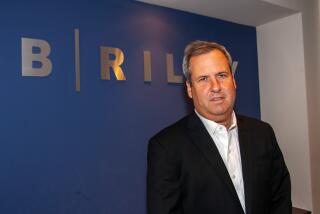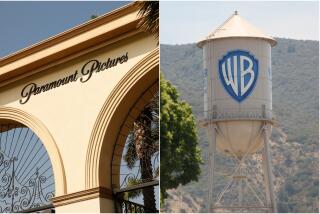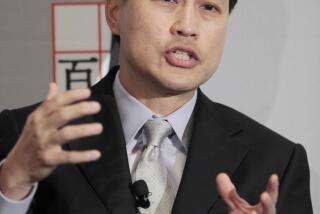Thrift Launches âWhite Knightâ Bid for Great Western
Setting up a takeover battle for dominance as the nationâs largest thrift, Great Western Financial Corp. said Thursday that it has agreed to be acquired by Seattle-based Washington Mutual in a deal valued at nearly $6.6 billion.
The deal tops a rival $5.9-billion bid by H.F. Ahmanson & Co., parent of Home Savings of America, but Ahmanson is expected to continue its fight, possibly by raising its offer. That would create a bidding contest reminiscent of Wells Fargo Bankâs successful fight for control of First Interstate Bancorp.
At stake is the right to become a banking behemoth with a huge branch and deposit network in California, which could shake up the market and provide stiff competition for giants Bank of America and Wells Fargo. Also, the thrifts are seeking to transform themselves from traditional savings and loans, relying on the business of making home loans, into banking companies that can provide consumers and businesses with a broader range of services. The winning suitor, by becoming much bigger, is likely to be in a better position to achieve this goal.
Also at stake is the fate of thousands of Great Western employees and dozens of branches. Great Western and Washington Mutual said their combination would result in the closure of about 200 branches and loan offices, and an undetermined number of job losses. But a takeover by Ahmanson would result in even more cuts, although that could boost the profitability of the combined companies--a point that Ahmanson is going to stress.
The outcome of the battle could be determined largely by which suitor is more successful at convincing Wall Street investors that its deal is the best.
Washington Mutualâs proposed merger would create Californiaâs third-largest financial institution, with $87.4 billion in assets, trailing only Bank of America and Wells Fargo. It would be the nationâs largest S & L, overtaking H.F. Ahmansonâs Home Savings and, in fact, putting that 108-year-old thrift in a precarious distant-second position in a fast-shrinking industry.
Ahmanson did not immediately try to top Washington Mutualâs proposal but said it remains resolved to complete its deal.
âI think ultimately the shareholders have to determine if they want to be associated with a growing company or a slash-and-burn liquidation,â said Kerry K. Killinger, chief executive of Washington Mutual.
âThe whole thingâs a home run and weâre going to get it done,â vowed Great Western Chief Executive John F. Maher, who would retire after the transaction and become a director of Washington Mutual.
Irwindale-based Ahmanson, which made its surprise unsolicited proposal for the Chatsworth thrift Feb. 17, remains âfully committed to our proposed transaction,â spokeswoman Mary Trigg said Thursday. She added that it is âimportant for shareholders to look at the two offers side by side, and it may take a couple of days to fully digest the details.â
But Ahmanson is expected to raise the ante because, if it doesnât, the thrift faces not only a stronger competitor in its own backyard, but also the prospect of becoming a takeover target itself. The financial services industry has been churned in the 1990s by a series of large mergers as banks and thrifts--the lines between them all but erased--pair up because of competitive pressures that require forging into new markets while cutting costs.
âThey go from being the eater to being the eaten,â said Los Angeles investment banker Lloyd Greif.
The proposed merger âbrings together two strong companies, which have been industry leaders in moving from the traditional thrift model to that of a consumer bank,â Killinger said. Many thrifts have taken this same road to broaden the services they offer and Washington Mutualâs lead in this area would bring Great Western customers such new products as home banking and bill payment by phone, analysts said.
Washington Mutual already owns Irvine-based American Savings Bank, which it bought last year for $1.7 billion. That would be combined with Great Westernâs operations under the Great Western name in California, Florida, Arizona, Nevada and Colorado.
Under the agreement, which has been approved by the boards of both companies, Great Western shareholders would receive 0.90 of a share of Washington Mutual stock for each Great Western share. The Ahmanson proposal, also a stock exchange, would give Great Western shareholders 1.05 shares of Ahmanson stock for each Great Western share.
On the New York Stock Exchange, Great Western shares jumped $1.875 to $46.875 Thursday, while Ahmanson shares fell $1.25 to $40.75. Washington Mutual shares slipped 25 cents to $53 on the Nasdaq.
At Thursdayâs closing prices, Washington Mutualâs offer worked out to $47.70 a share, or $6.56 billion. With the slippage in its stock price, Ahmansonâs deal fell to $42.79 a share, or $5.88 billion. Before the Ahmanson bid on Presidents Day last month, Great Westernâs stock closed at $34.25 a share.
The appearance of Washington Mutual as a friendly âwhite knightâ suitor was not a surprise. In recent days, Great Western had taken a number of steps to discourage Ahmanson, while Washington Mutual, a highly regarded institution that made its foray into California with the acquisition of American Savings Bank and its 158 branches, publicly reiterated its intention of becoming a bigger player in the strengthening California economy.
Great Western said about half of the locations it would close after a merger with Washington Mutual would be consumer financial services branches. The actual number of thrift branch closures would still be less than the 180 planned in California by Ahmanson in its merger proposal.
Ahmanson and Great Western, rivals that have paced each other like runners ever since the post-World War II housing boom, have nearly 150 branches that are within a mile or so of one another. And for precisely that reason, analysts had viewed an Ahmanson-Great Western deal as more likely than a merger with an out-of-state institution, given Ahmansonâs claim that it can slash $400 million in annual expenses by late 1998 by eliminating thousands of jobs.
In comparison, analysts have estimated that Washington Mutual could probably shave no more than $250 million in expenses--a figure that Washington Mutual disputed on Thursday, claiming $340 million in expense reductions in 1999.
At the same time, Washington Mutual has some advantages over Ahmanson.
Killinger, who came to Washington Mutual in 1983 through an acquisition, is noted for his skill in buying companies, having completed two dozen acquisitions in the last dozen years.
Moreover, analysts believe Great Western and Washington Mutual would be better able to work out issues such as the integration of operations and employee cuts. Indeed, Great Western had severely criticized Ahmansonâs chief executive, Charles Rinehart, for stating that only Great Western employees would face layoffs in a merger.
This latest financial services face-off is reminiscent of the takeover battle between Wells Fargo & Co. and First Interstate in 1995-96. In fact, analyst Thomas OâDonnell of Smith Barney said it was âeerieâ how closely the action so far has paralleled that earlier fracas.
Like Ahmanson, Wells opened with a surprise hostile bid, which First Interstate rejected. Then, like Great Western, First Interstate fought back by finding an out-of-state âwhite knightâ in First Bank System Inc. of Minneapolis.
First Interstate and First Bank trumpeted their proposed merger agreement in a joint news conference much like Thursdayâs, talking up the growth and ârevenue enhancementâ potential of their deal while deriding the cost-cutting emphasis of the rival bid.
What ultimately won the battle for Wells Fargo was the way Wall Street sized up the competing bids. As investor sentiment swung toward Wells Fargo, its stock climbed, enhancing the value of its offer, while First Bankâs stock--and the value of its deal--treaded water.
Clearly, Ahmanson is hoping that the same thing will happen here. To help the process along, advisors to the Irwindale-based S & L have begun a quiet but energetic jawboning campaign to cast doubt on Washington Mutualâs offer.
Another parallel to Wells Fargo-First Interstate is the dealâs potential for becoming a political football.
Los Angeles Mayor Richard Riordan emphatically took sides in the earlier deal, backing First Interstateâs proposed marriage with First Bank System because it would have resulted in far fewer job losses in Southern California than the Wells Fargo scenario.
Riordan, who was in Washington on Thursday, has not yet declared a position on the Ahmanson-Great Western deal. A spokesman said the mayor continues to monitor the developments.
The current battle is a trickier call for Riordan. Although Ahmansonâs offer would result in more job losses for the area, the result would be that the nationâs largest thrift would still be located in Greater Los Angeles--Irwindale, specifically. Under Washington Mutualâs proposal, fewer jobs would leave, but Los Angeles would lose yet another headquarters of a major financial institution. Washington Mutual made it clear that headquarters would remain in Seattle.
As part of the transaction, Washington Mutual would take a pretax charge of $440 million, including $100 million added to its financial reserves to protect the institution against bad loans. The transaction, which is subject to shareholder and regulatory approval, would close in the third quarter of 1997.
Times staff writer Don Lee contributed to this story. Rivera Brooks reported from Los Angeles and Mulligan from New York.
* THE PLAYERS: A look at the key people deciding the takeover fight. D1
More to Read
Inside the business of entertainment
The Wide Shot brings you news, analysis and insights on everything from streaming wars to production â and what it all means for the future.
You may occasionally receive promotional content from the Los Angeles Times.










